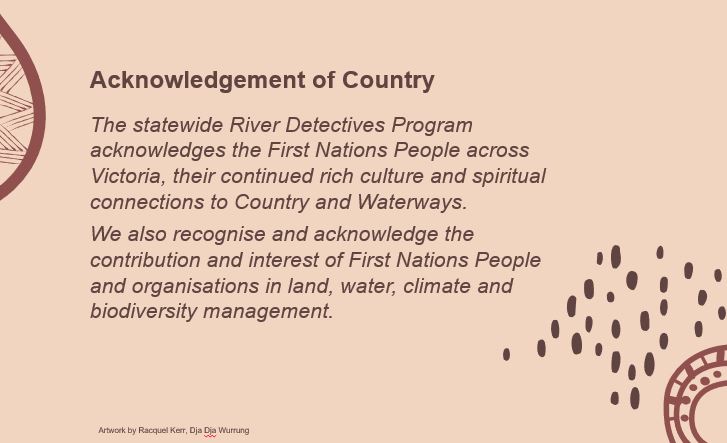All
Video stories showcasing River Detective participants
The River Detectives program can be adapted to suit the needs of participating groups. You can find written and video stories here to ishowcase the variety of ways that participants have embedded the program into curriculum, leveraged off the program to achieve broader sustainability goals or completed innovative projects; Bridgewater PS, Stawell PS, Dean’s Marsh PS, Victory Christian College, Covenant College, Minyip and Rupanyup Kindergartens, and Wandiligong PS.
|
Sustainable Farms – enhancing dams resources
Dams are well-known features of farming landscapes. They are also valuable natural assets. ANU’s Sustainable Farms project works with farmers, land managers, NRM agencies, industry groups and Landcare towards a common goal: healthy farms, healthy farmers and healthy profits. They offer a range of great resources: a farm dam poster, life in a farm dam activity sheet, the Enhancing Farm Dams guide and the farm dam planting guide. For some great videos watch: Improving farm dams – a farmer’s perspective, life in a farm dam – after fire comes recovery and building a wildlife island on a farm dam. If constructing or renovating a dam, for the farm dams technical guide click here.
|
Reimagining Bendigo Creek Installation video
A short video montage from an art installation in the Bendigo Conservatory celebrating what Bendigo Creek habitat provides and what it could provide in future.
|
Aussie Backyard Bird Count
The Aussie Backyard Bird Count is an annual citizen-science event held in National Bird Week (October). It is a great way to connect with the birds in your backyard no matter where your backyard happens to be — a suburban backyard, a local park, a patch of forest, down by the beach, or the main street of town. You can use the App to do as many 20-minute surveys as you like over the week with the data collected assisting BirdLife Australia understand more about the birds that live where people live. Use the lesson plans to explore birdwatching at school. Check out an infographic of the 2020 results for some great maths stats.
|
Waterbug Discovery video
Join Deirdre and Kristen from Corangamite CMA for a great introduction to waterbugs in the Corangamite region. Get to know your regional River Detective staff, how to conduct a sampling session and the creatures you might find. For lower primary students, pause the video to read the text slides aloud. The Now and Then resource referred to is also found on the River Detectives website.
|
Catchment to tap video
This video has been produced by Central Highlands Water but the majority of content is relevant to all areas of the state. It features simple explanations of a catchment, the water cycle, how water is shared between users and how water is treated to make it safe in our urban water system.
|
Water Cycle Meditation no. 2
This guide is useful if you would prefer to step your own class through a water cycle meditation. Teacher notes include a mindfulness colouring sheet and instructions to make a calming jar. Alternatively you can play an audio of the meditation thanks to Barwon Water.
|
Edible aquifer video and experiment
Join Meg Humphrys, author and illustrator of ‘When Water Lost Her Way’ (see Photo/Story Book section of Resource River Bank) for a wonderful edible aquifer experiment students can do to understand groundwater and the water table. Delicious and educational at the same time !
|
Sharing culture across Wadawurrung country video
ABC’s ‘This Place’ project invites Aboriginal and Torres Strait Islander people to create a short video about a place name, and the story behind it. Bryon Powell takes us on a journey across Wadawurrung country, sharing some of the stories behind its place names. His country stretches from the mountains to the sea. It includes hills, rivers and grassy plains, creeks and coasts and includes modern towns such as Werribee, Geelong and Ballarat in Victoria. Search for other videos of cultural stories about waterways across regional Australia at the ABC TV Education website, on ABC iview or at the ABC Indigenous youtube channel.
|
Sharing culture at Barengi Djul (Wimmera River) video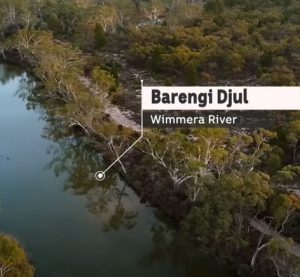
ABC’s ‘This Place’ project invites Aboriginal and Torres Strait Islander people to create a short video about a place name, and the story behind it. The Wimmera River is known as Barengi Djul in Wergaia language spoken by the Wotjobaluk people. Along the water, not far from the township of Dimboola is a special place known as Ackle Bend or Wutiyeti which means camping place, and is also known for its stories of Bunyip. Search for other videos of cultural stories about waterways across regional Australia at the ABC TV Education website, on ABC iview or at the ABC Indigenous youtube channel.
|
Seeing the land from an Aboriginal canoe video
This 10 minute video gives a wonderful insight into the way 19th century European settlers depended on Aboriginal navigators and canoe builders to transport goods, stock and people. This short documentary film explores the little known contribution Aboriginal people made in colonial times across the river systems of Victoria. It features interviews with the historian Associate Professor Fred Cahir and Traditional Owners Uncle Bryon Powell, Jamie Lowe and Rick Nelson. For other cultural/historical videos, documents, photos, etc about waterways near you, type the name of your creek/river into the search bar of the Collection Search tab of the Culture Victoria website. You’ll be amazed at what you find !
|
Introducing waterbugs video
This short 3 minute video by Priya from Melbourne Water is a fabulous tool to introduce waterbugs to your students; what they are, how they live, their wonderful adaptions, why they are so important to the aquatic ecosystem and how they can help us assess water quality and habitat diversity.
|
Make your own window sill pond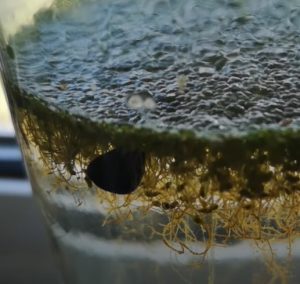
This series of videos takes you on a journey watching the development of a window sill pond over three weeks. Take a look then give it a go with your students ! See how the pond evolves during Week 1, Week 2 and Week 3.
|
How to take great waterbug photos with your device
This video by waterbug guru John Gooderham of The Waterbug Company is full of tips and tricks to take great photos of macroinvertebrates with an iphone when using The Waterbug App for identification. Designed so that photos can be uploaded as part of the National Waterbug Blitz program, this video is just as relevant for River Detectives to study waterbugs and record findings digitally.
|
How beetles breathe under water video
A great video from the Deep Look youtube channel analysing the adaptions beetles have developed to survive and thrive in their aquatic environments. Students will love this peek into the amazing world of water beetles. Check out Deep Look on youtube for other fascinating videos about the lives of terrestrial bugs.
|
Water Striders up close video
A great video from the Deep Look youtube channel analysing the various ways that water striders have evolved to become expert hunters of their aquatic prey. Students will love this peek into the amazing world of water striders. Check out Deep Look on youtube for other fascinating videos about the lives of terrestrial bugs.
|
Water Spider v Water Strider video
A great video from the Monster Bug Wars youtube channel showcasing the unique adaptions of water striders and how they would match up in a battle against a water spider.
|
Resourcing your macroinvertebrate sampling kit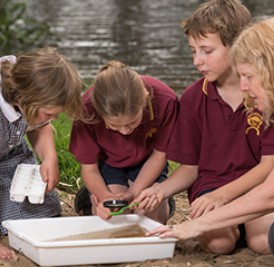
Autumn and/or Spring are great times to sample with students. Sampling equipment can be borrowed from your Regional River Detectives Coordinator. Contact them to book it ahead of time. Ideally it’s wonderful to sample several times a year and across different seasons so students can practise their skills regularly and observe patterns/changes. Having your own sampling equipment at school ready to go means that you’re more likely to grab opportunities to conduct macro sampling without the hassle of borrowing equipment. Most equipment is readily available but specialised equipment such as a sampling net and picking trays can be purchased at The Waterbug Shop or Westlab (a great use of grant funding/sponsorship if you have a supportive local Landcare group or business)
|
Reimagining Our Water Future activity matrix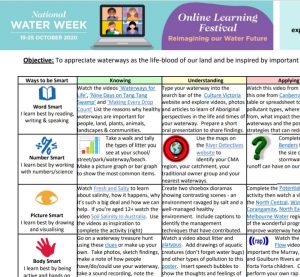
As part of the River Detective Program’s participation in the statewide 2020 National Water Week Online Learning Festival we put this activity matrix together to offer engaging, multi-age, cross-curricular activities using a variety of learning styles to explore the theme; ‘Reimagining Our Water Future’. The matrix is a compilation of challenges from a suite of activity matrices under development by the River Detectives program available for registered RD participants and located in this website under the Dive Deeper tab (login required). Use the matrix to enjoy National Water Week or anytime !
|
On The River picture story book
This book is a delight for all ages from the creator of the bestselling At the Beach series. Follow the mighty Murray River from its smallest beginnings in the mountains to where it meets the sea on an epic journey with Roland Harvey and his pelican friend, in this glorious picture book full of humorous, intricate illustrations and fascinating information. Together they discover the story of the river: its secrets, history, ecology, people and animals. And you’re invited, too! There are no online versions of this book but a hard copy can be ordered at your favourite book store. Teacher’s notes are available along with a worksheet for younger readers.
|
City of Kingston Stormwater Treatment and Reuse Project video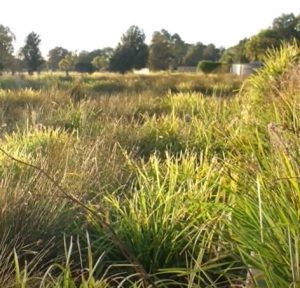
Watch this short video to see how the City of Kingston (Melbourne) are minimising flooding in the low-lying suburb of Edithvale by capturing stormwater, filtering it and reusing it to enhance the suburb. A great example of innovative design helping people and the environment.
|
Stormwater Harvesting at Fitzroy Gardens video
Each year, 120 million litres of water are used to water the Fitzroy Gardens. Since installing a state-of-the-art stormwater harvesting system Melbourne City Council have reduced the use of top quality mains drinking water by 60%. This fantastic video brings diagrams to life showing each step in the process.
|
Innovative Stormwater Solution videos
There are many inspiring programs using innovative inventions and multi-media campaigns to prevent stormwater pollution and raise community awareness of the issue. Check out ‘trash traps’ at the linked title above or any of the following; ‘sea bins‘, ‘drain socks‘, ‘soundscapes‘, ‘litter trackers‘, ‘rain gardens‘ and ‘stormwater stencils‘. Challenge students to do a PMI or venn diagram to compare and contrast each approach.
|
Ocean Pollution videos
Regardless of where you are in the state, it is very important for your students to understand how the rubbish they drop could potentially end up in the ocean. The linked title will take you to a short video about the Pacific Ocean garbage dump. Alternatively you can view a 24 minute documentary, “A Plastic Wave” . Many other longer documentaries are available on streaming platforms and get updated regularly. Please be aware that ocean pollution and its impact on sea creatures can introduce disturbing images and information to students – please choose appropriately for different age groups and implement with care.
|
Urban Stormwater Journey photos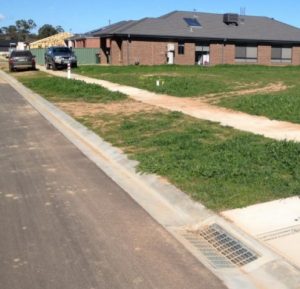
This series of five photos and short explanations clearly illustrate the journey of rainfall from an urban roof, road or footpath into a nearby waterway.
|
Rubbish In The River envirostory
This example of a student-written/illustrated book comes from the Enviro-Stories website. It is a great example of how the River Detectives program can be embedded into the curriculum and inspire literacy projects. The topics are endless for solo/group writing challenges. Check out the enviro-story library for more ideas regardless of how books are eventually published.
|
Wilam: A Birrarung Story
Wilam: A Birrarung Story is written by Aunty Joy Murphy and Andrew Kelly and illustrated by Lisa Kennedy. It tells the Indigenous and geographical story of Melbourne’s Yarra River, from its source to its mouth, from its pre-history to the present day and includes words from the Woiwurrung language. There are no online versions of this book but a hard copy can be ordered at your favourite book store. Comprehensive cross-curricular teacher’s notes are a wonderful guide to implementing this beautiful book in the classroom.
|
Urban Stormwater photos
These photos of stormwater sources, stormwater pits/pipes/swales, stormwater pollution, impacts of pollution, pollution prevention strategies and stormwater management solutions can be used as a springboard for discussion, in conjunction with lessons in the Urban Stormwater Environmental Education Resource (see Topics-Urban Water) or with some of the activities on the Urban Stormwater/Rural Runoff activity matrix found under the Dive Deeper tab.
|
Catchment/Waterway photos
These photos of catchments, healthy and threatened waterways, wetlands and rehabilitation strategies can be used as a springboard for discussion, in conjunction with lessons in the Waterways Environmental Education Resource (see Topics-Waterways) or with some of the activities on the Waterways activity matrix found under the Dive Deeper tab.
|
Victorian Water Corporations map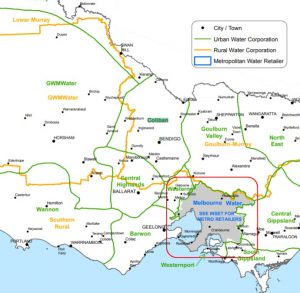
Although the role of water corporations is different to CMA’s (who manage urban water), there is a shared interest in water health/management and the two sectors collaborate regularly. Of great interest to the River Detectives program is the wonderful education services that these water corporations often offer with incursions, excursions, teaching resources and activity sheets for students of all ages looking at urban water, the water cycle and water conservation. Use this map to see which urban water corporation zone your town/school falls in. Head to the group/organisation section of Resource Riverbank for a link to the education tab of each corporation’s website. Consider getting in touch to access their programs, broaden your studies of water and value add to the River Detectives program.
|
North East Water education program
For schools in the North East CMA region, North East Water offer incursions, excursions and resources for students and teachers to educate about urban water, the water cycle and saving water.
|
Barwon Water education program
For schools in the Corangamite CMA region, Barwon Water offer a free comprehensive education program including water-related incursions, excursions and resources for early childhood to tertiary students. You can also sign up for their e-newsletters.
|
Central Highlands Water education program
For schools in the south-western part of the north central CMA region and the northern part of the Corangamite CMA region, Central Highlands Water offer free education programs and learning materials for schools and community groups. Topics include; water (source to tap), water efficiency, choose Tap and recycled water and wastewater.
|
GWM Water education program
For schools in the Wimmera, GWM Water offers a range of water-based activities, experiments, fact sheets, puzzles and fun recipes specific to your region. They also encourage schools to enter the annual National Water Week poster competition.
|
Now and Then waterbug guide
This booklet was produced quite some time ago by Corangamite CMA but remains a fantastic resource with waterbug profiles including fantastic photos showing the scale of bugs compared to a five cent piece, life cycle sketches, did you know facts and sketches/descriptions of the six main types of waterbug mouthparts (useful graphics for student research projects). Information and graphics from this booklet have also been used to produce our Waterbug Fact Sheets.
|
Wetland Illustration
This illustration can be printed at A3 size to outline the important values of wetlands and highlight the factors that threaten their health.
|
NCCMA region Traditional Owner map
This map (current July 2020) shows the Traditional Owners within the North Central CMA region and it’s catchments.
|
Richardson River’s Journey posters
These two posters are an excellent resource for staff and students to familiarise themselves with the Richardson River – it’s; source, path, reaches, catchment, major towns, history, most notable features, flora, fauna and users. The engaging format, stunning photos and user-friendly text makes it the perfect tool for teacher background, student-lead research and learning about an important waterway in the north central region.
|
Re-snagging posters
These two posters are invaluable to explain the importance of in-stream woody habitat to native fish and explains some of the important work that is taking place in the lower Loddon River and the Little Murray River as part of the north central CMA’s native fish recovery plan. Features include great photos, fact files, information and an excellent diagram outlining the threats and values in a waterway that impact on fish health.
|
Coliban River’s Journey poster
This poster is an excellent resource for staff and students to familiarise themselves with the Coliban River – it’s; source, path, catchment, major towns, history, most notable features, flora, fauna and users. The engaging format, stunning photos and user-friendly text makes it the perfect tool for teacher background, student-lead research and learning about an important waterway in the north central region.
|
Water Birds of the Loddon River poster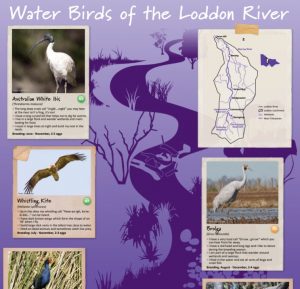
This is a wonderful poster showcasing six of the most important native water bird species of the Loddon River. It features a map of the Loddon River and its catchment and fact files on six water bird species outlining; appearance, size, life cycle, habitat, diet, breeding, behaviour, calls and conservation status. Use the Natureblitz App to listen to calls and record sightings.
|
Frogs of the Loddon River poster
This is a wonderful poster showcasing six of the most important native frog species of the Loddon River. It features a map of the Loddon River and its catchment and fact files on six frog species outlining; appearance, size, life cycle, habitat, diet, breeding, behaviour, calls and conservation status. Use the Natureblitz App to listen to frog calls and record sightings.
|
Fish of the Loddon River poster
This is a wonderful poster showcasing six of the most important native fish species of the Loddon River. It features a map of the Loddon River and its catchment and fact files on six fish species outlining; appearance, size, life cycle, habitat, diet, breeding, behaviour and conservation status. Use the Natureblitz App to record sightings.
|
Avoca River’s Journey posters
These three posters are an excellent resource for staff and students to familiarise themselves with the Avoca River – it’s; source, path, reaches, catchment, major towns, history, most notable features, flora, fauna and users. The engaging format, stunning photos and user-friendly text makes it the perfect tool for teacher background, student-lead research and learning about an important waterway in the north central region.
|
Loddon River’s Journey posters
These three posters are an excellent resource for staff and students to familiarise themselves with the Loddon River – it’s; source, path, reaches, catchment, major towns, history, most notable features, flora, fauna and users. The engaging format, stunning photos and user-friendly text makes it the perfect tool for teacher background, student-lead research and learning about an important waterway in the north central region.
|
Campaspe River’s Journey posters
These two posters are an excellent resource for staff and students to familiarise themselves with the Campaspe River – it’s; source, path, reaches, catchment, major towns, most notable features, flora, fauna and users. The engaging format, stunning photos and user-friendly text makes it the perfect tool for teacher background, student-lead research and learning about an important waterway in the north central region.
|
Waterbirds Field Guide of the North Central region
This guide produced by North Central Waterwatch includes fact files on waterbird species; description, distribution, diet, calls, breeding, habitat and conservation status. Beautiful photos make it a great asset for birdwatching at any waterway.
|
Habitat Survey Data Sheet
Use this data sheet on site or at school to record your habitat survey results. You can enter your habitat survey data online at the ‘Let’s Test and Record’ tab of this website.
|
Waterbug Data Sheet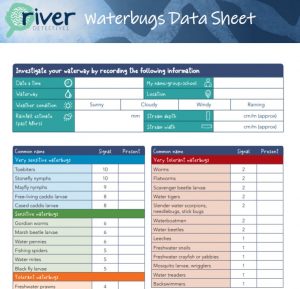
Use this data sheet on site or at school to record your waterbug data after sampling. You can enter your waterbug data online at the ‘Let’s Test and Record’ tab of this website.
|
Water Quality Data Sheet
Use this data sheet on site or at school to record your water quality data each month. Make sure you enter your water science data online at the ‘Let’s Test and Record’ tab of this website.
|
Fish Need Trees poster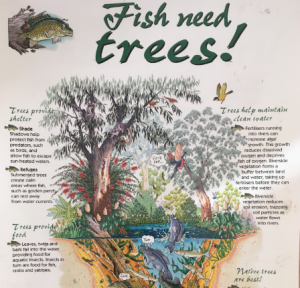
This beautiful graphic illustrates the variety of ways that fish use trees in and beside waterways and why it’s essential we retain and replace them.
|
Fish Need Healthy Rivers poster
This is a great poster highlighting the features of waterways that fish require for food, shelter, breeding and migration, from source to mouth.
|
Waterbug fact sheets
Comprehensive fact sheets on a variety of bugs in each of the sensitivity categories including photos and labelled sketches with information on size, appearance, habitat, diet, movement, predators, life cycles and other interesting facts.
|
The Wimmera’s Flowing Tale video
Take a journey along the depth and breadth of the Wimmera River catchment. Produced in 2006, this short film is a fantastic look back at our river system. It focusses on how Wimmera CMA looks after the catchment and how they manage environmental water releases. Although many things have changed since this film was made, such as completion of the Wimmera Mallee Pipeline and more security for environmental water releases, the themes in this flowing tale have stayed the same.
|
Water Quality Rating Charts
Numbers are just numbers until you work out what they mean. Use the regional water quality rating chart from the Field Manual in your kit to compare your data for EC, turbidity, reactive phosphorus and pH to assess the health of your waterway. Or use the links below to print an enlarged copy for student use; Corangamite CMA, Melbourne Water, North East CMA, North Central CMA, Wimmera CMA
|
Bendigo Creek Citizen Science Project student presentation videos
The Reimagining Bendigo Creek aims to create a healthier, more inclusive, connected and beautiful Creek that we can all respect and value. After attending a workshop in 2019 about the assets and threats of Bendigo Creek, students were challenged to present their vision for a future Bendigo Creek and their innovative results were amazing ! View Huntly Primary School’s creative lego model presentation at the title link above and Epsom Primary School’s engaging video here as inspiration for your own student-led waterway championing project.
|
Urban Stormwater brochure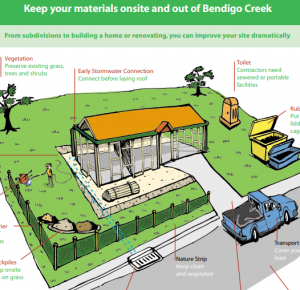
This brochure produced by the Bendigo Urban Stormwater Program details the responsibilities of builders/renovators/land developers to manage runoff from building sites. Diagrams and captions clearly explain positive strategies to reduce impacts and demonstrate an example of a subdivision considering water-sensitive urban design. This is a useful resource for any region.
|
Urban Stormwater poster
This poster is a fantastic resource to use demonstrate the impact of litter that can flow into a waterway with urban stormwater. It highlights the often unknown fact that only 10% of waterway litter is visible from the surface and a disturbing 90% will be hidden under the water. The Water Bug pictures could be placed on the poster to create discussion about how they (and other fauna) would be impacted by stormwater pollution and how this would impact on the entire food chain.
|
Salinity Solutions poster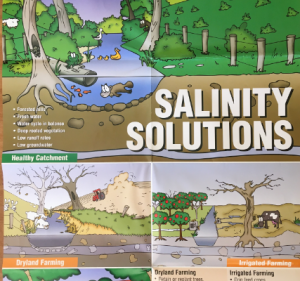
Print this coloured poster at A4 or A3 size for a great visual aid to discuss the features of a healthy catchment and the strategies to reduce salinity in dryland farming, irrigated farming and urban areas.
|
Golden Perch Profile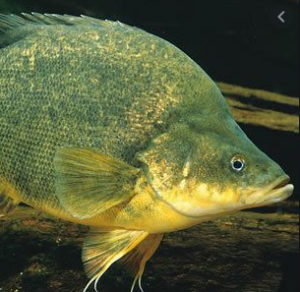
Find out about Golden Perch and their distribution across northern Victorian waterways.
|
Murray Cod Profile
Find out about Murray Cod and their distribution across northern Victorian waterways.
|
North East CMA
Find out what the North East CMA does and how they care for catchments in the region. Includes descriptions of the region and projects the CMA is undertaking to protect and enhance environmental values within the region. If you are in the North East CMA region you may also like to access educational support (urban water, water cycles, water conservation) from the water corporation in your specific location using this map. It will most likely be North East Water.
|
Melbourne Water education program
Find out what Melbourne Water does and how they care for catchments in the region. Includes a myriad of education resources covering frogs, litter, stormwater, catchments, waterways and more. Some are specific to the Melbourne area but many are relevant to all regions. If you are in the Melbourne Water area you may also like to access support from the water corporation in your specific location using this map. It will either be Yarra Valley Water, South East Water, City West Water or Westernport Water.
|
Corangamite CMA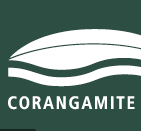
Find out what the Corangamite CMA does and how they care for catchments in the region. Includes descriptions of the region’s catchments and projects the CMA is undertaking to protect and enhance them. If you are in the Corangamite CMA region you may also like to access educational support (urban water, water cycles, water conservation) from the water corporation in your specific location using this map; Depending on your location it may either be Central Highlands Water or Barwon Water,
|
North Central CMA
Find out what the North Central CMA does and how they care for catchments in the region. Includes great descriptions of rivers and wetlands in the region and projects the CMA is undertaking to protect and enhance them. If you are in the North Central CMA region you may also like to access educational support (urban water, water cycles, water conservation) from the water corporation in your specific location using this map; Depending on your location it may either be Coliban Water, Central Highlands Water, GWM Water or Lower Murray Water.
|
Wimmera CMA
Find out what the Wimmera CMA does and how they care for catchments in the region. Includes great descriptions of rivers/streams and wetlands in the Wimmera CMA region. If you are in the Wimmera CMA region you may also like to access educational support (urban water, water cycles, water conservation) from the water corporation in your specific location using this map. It will most likely be GWM Water.
|
Wimmera Water Short Stories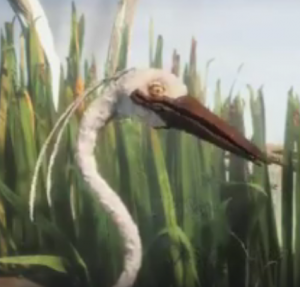
Our waterways are very special and mean something to each of us. In this series of three short stories the Wimmera CMA have been innovative and put the voices and stories of people in their region to the animated characters of the Fresh and Salty film. In Story 1 at the title link above, a tree (farmer) talks about his family being a guardian to the river over many generations. In Story 2 members of the community appear as a mosquito, fish and mollusc to tell how it feels to waterski on the river or sit beside it. In Story 3 an egret and fish share what the river means to the young and old.
|
Wimmera River at Jeparit flows into Lake Hindmarsh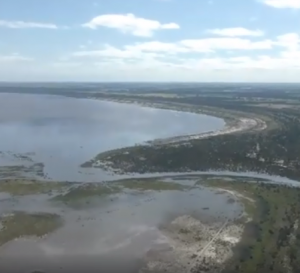
In September 2016 the Wimmera region enjoyed seeing many of their waterways flowing and lakes filling! The CMA filmed the breathtaking sight of Lake Hindmarsh from the air with the majority of the lake’s 139 square km surface area covered by water. Lake Hindmarsh is Victoria’s largest freshwater lake. Previously it filled after the 2011 floods but since then had been dry. It is a popular spot for camping, birdwatching, sailing and brings visitors from around the world. The lake also supports a diverse array of plants and animals including birds, frogs, fish and river redgums.
|
Waterways for life – healthy rivers, healthy communities
The Wimmera River in Western Victoria is where many people start or end their days, socialise, gather and be part of community events.
In this story by the Wimmera CMA join marathon swimmer Tammy Van Wisse and Wimmera locals to see just how much people rely on healthy waterways for their own physical and mental health. Healthy rivers also keep communities vibrant and alive by bringing everyone together – whether it’s for a walk, a run, a paddle, special event, fishing or just a picnic.
|
Finding Hope – Wimmera Platypus Surveys
The Wimmera CMA take you behind the scenes of their MacKenzie River platypus surveys in the Grampians. This footage was filmed during their 2019 autumn surveys. In the spring of that year they returned and filmed more beautiful footage of a male platypus.
|
World Wetlands Day – A Wimmera Wetland video
To celebrate World Wetlands Day 2020 the Wimmera CMA zoomed in on Dock Lake near Horsham that received water for the first time in two decades in 2016. They recorded the great diversity and abundance of waterbirds that flocked to the lake, showing how adding water to wetlands can trigger a huge response from nature.
|
The Wimmera – A Flowing Fish Tale video
This video produced by Wimmera CMA is a great example for all regions of how a healthy river that strikes the balance between the needs of plants, animals and people can build a vibrant community. It shows that strategies ensuring healthy fish populations boosts the enjoyment of the river by local and visiting anglers and sends the message that if you look after the river, it will look after you.
|
Salinity Photos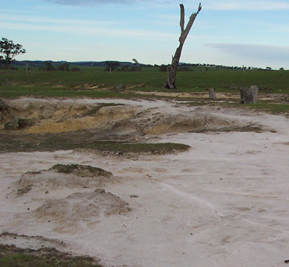
These photos of salt-ravaged land, healthy land, restoration strategies and urban salinity can be used as a springboard for discussion, in conjunction with lessons in the Salinity Environmental Education Resource (see Topics-Salinity) or with some of the activities on the Salinity activity matrix found under the Dive Deeper tab.
|
Restoring salt affected land video
West Australian farmers Tim and Val Saggers have been restoring salt affected land on their farm for more than a decade, using native perennial shrubs and grasses. Although native perennial pastures are not yet a popular option in WA compared to the eastern states, the Saggers’ have not been deterred and have managed to reclaim once unproductive land and made their farm more productive and sustainable for future use. Although not a local example, this video follows principles that are effective in any salt-ravaged environment.
|
Mooroobull Yaluk Kuwin River Day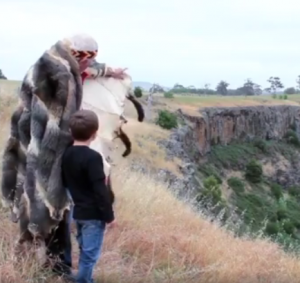
In February 2018 the Corangamite CMA and Wathaurung Aboriginal Corporation hosted a community fishing day with the Wadawurrung community on the Moorabool River.
|
Celebrating Water and Culture on The Mooroobull Yaluk
Corangamite CMA worked with the Wadawurrung Traditional Owners in developing a joint bid for additional water for the Moorabool River. This was to protect the environmental and Aboriginal values within the rivers on Wadawurrung Country. The bid was successful and an additional 500 megalitres was released down the river when it was most needed. This allowed the Wadawaurrung community to come together, practice cultural values and share their knowledge.
|
Making Every Drop Count video
When Ian Campbell and Dr Sue Swaney bought their Deans Marsh farm in 1988, the landscape had only seven trees and a large erosion gully that nearly split the property in half. The transformation they’ve achieved in just three decades is astounding. In recent years the Corangamite CMA’s On-Farm Water Efficiency Project has supported Ian and Sue to design and manage a state-of-the-art farm water supply system to improve outcomes for animal health, catchment health and biodiversity. This is a great example for any region of the responsibility that all landowners in a catchment have toward waterway health.
|
Barwon River Planting Day video
Over 40 local recreational anglers braved wet and windy conditions in July 2019 to help revegetate the Barwon River. Thousands of native trees, shrubs and grasses were planted on the banks of the lower Barwon River near Marshall, south of Geelong, to return a one kilometre stretch of the river to its original woodland habitat. This is a great example of working together to improve fish habitat.
|
iNaturalist Citizen Science App Instructions
Instructions on how to download and use the iNaturalist app, developed by Corangamite CMA.
|
PlatypusSpot Citizen Science App Instructions
Instructions on how to download and use the PlatypusSpot app, developed by Corangamite CMA.
|
FrogID Citizen Science App Instructions
Instructions on how to download and use the FrogID app, developed by Corangamite CMA.
|
‘Birds in Backyards’ seasonal bird survey program
Get involved in seasonal bird surveys with Birdata, Birdlife Australia’s easy-to-use website and app. Both resources automatically give you a list of 30 birds from your region to help get you started – so you don’t need to be an expert to take part. Use this video to learn how to get started using the Birdata website to enter your results or, if you are a maths maniac, browse, filter, graph, analyse and compare bird data from anywhere in Australia. The App is a portable conservation tool allowing volunteers to leap into the colourful world of birdwatching and enter bird survey data via phones or tablets. You can also get involved in the Aussie Backyard Bird Count in October each year, a nationwide citizen-science event.
|
Wild Pollinator website
The Wild Pollinator Count gives you an opportunity to contribute to wild pollinator insect conservation in Australia. Twice a year (April and November) the community is invited to count wild pollinators in the local environment and help build a database on wild pollinator activity. You can join in by watching any flowering plant for just ten minutes sometime in the count weeks.
|
Victorian Fauna Field Guide App
Explore Victoria’s unique and diverse wildlife at home or in the great outdoors with Museums Victoria’s free Field Guide app. Available for both Apple and Android devices, the app holds descriptions of over 950 species, including birds, mammals, fishes, reptiles, frogs and invertebrates from terrestrial, freshwater and marine environments. Bird and frog calls, where held, can also be played for enjoyment and identification.
|
ABC Education website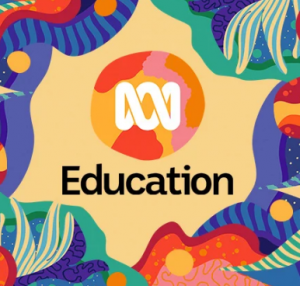
Thousands of free curriculum-linked resources for school teachers and students! Search for the topic you require and there may be activities, lesson plans or videos ready for you to use.
|
Cool Australia website
Cool Australia has been supporting teachers since 2008, providing them with learning activities and resources that make teaching and understanding real world scenarios as easy as possible. Units, lessons and activities are Australian curriculum aligned and FREE to educators and students. You can choose to follow full units of study or pick individual lessons to fit in with your curriculum. There are a multitude of resources from a variety of curriculum areas that provide content aligned with topics covered by the River Detectives program.
|
Victorian CMA regions
This map shows the Catchment Management Authority regions across Victoria. In each region, CMA’s are responsible for the management of waterways. Maybe you could research what the major waterways are in each region ?
|
Culture Victoria: Aboriginal Culture
Culture Victoria is a gateway to Victoria’s cultural collections and organisations. It provides access to images, videos and stories that showcase the richness and diversity of Victoria. Type a location or waterway into the Collection search to discover content from cultural agencies and over 300 professional and community collections.
|
Frogs Field Guide of the North Central region
This guide produced by North Central Waterwatch includes fact files on frog species; description, calls, breeding, eggs, tadpoles, habitat and conservation status. It also clearly explains the different types of pupils, toes and eggs that can assist with frog identification. The frog profiles are also available as fact sheets; Growling Grass Frog, Peron’s Tree Frog, Southern Brown Tree Frog, Whistling Tree Frog, Barking Marsh Frog, Bibron’s Toadlet, Common Froglet, Common Spadefoot Toad, Giant Banjo Frog, Plains Froglet, Pobblebonk, Southern Toadlet, Spotted Marsh Frog, Striped Marsh Frog and Victorian Smooth Froglet.
|
Fish Field Guide of the North Central region
This guide produced by North Central Waterwatch includes fact files on fish species; description, breeding, fins, eggs, habitat, diet and conservation status including threats. A map showing the fish species approximate distribution in the North Central CMA region and a breeding cycle calendar is also provided for each species, along with a photo or two. The fish profiles are also available as fact sheets; Short-headed Lampray, Bony Bream, Common Galaxias, Mountain Galaxias, Flat-headed Galaxias, Spotted Galaxias, Australian Smelt, Freshwater Catfish, Murray Hardyhead, Un-specked Hardyhead, Murray-Darling Rainbowfish, Golden Perch, Macquarie Perch, Trout Cod, Murray Cod, Silver Perch, River Blackfish, Southern Purple-spotted Gudgeon, Flathead Gudgeon, Dwarf Flathead Gudgeon, and Southern Pygmy Perch .
|
Catchments – the sponge effect video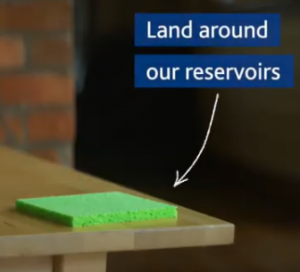
Only around 30% to 50% of the rain that falls on our catchments each year ends up in waterways. For example, only about 10% of rainfall during summer turns into runoff because the dry soil acts like a sponge, soaking up the rain before it can flow into streams. Watch this video to see how this changes from season to season depending on how wet the soil in the catchment is.
|
Melbourne’s drinking water video
Learn why Melbourne’s water tastes great straight from the tap !
|
Urban Water Cycle animations
People have changed the natural water cycle; buildings and pipes take water for drinking and remove sewage and stormwater. This is the urban water cycle. In Melbourne the urban water cycle is managed by Melbourne Water. Use this interactive map to learn more or this link to explore other aspects. In north central Victoria Coliban Water manages urban water. Check out their animation with links to videos to explore topics further.
|
Woodend PS planting day video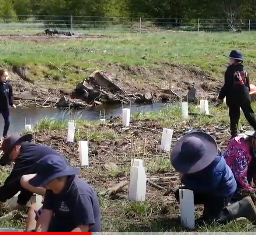
In October 2019, the NCCMA worked with Coliban Water and Dja Dja Wurrung to hold a planting day on the banks of the Campaspe River with Grade 4 students from Woodend Primary School. Students helped to plant some of the 20,000 native trees and shrubs, and learned about the positive impact the plants and fencing will have on water quality and catchment health.
|
River Detectives involved in river health video
This video explains how River Detectives schools can be integrally involved in river health projects when they partner with NCCMA projects and local Landcare groups. See examples of how Woodend and Goornong primary schools enjoy participating.
|
Birth of the Brolga
Rare footage of a pair of brolga incubating and rearing two chicks highlights the need for a plan to deliver environmental water to wetlands.
|
Frogs at McDonalds Swamp and Wirra-Lo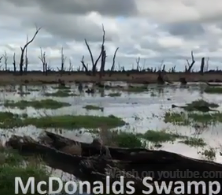
Delight at the sound of the frog chorus in two of north central Victoria’s wetlands.
|
Aunty Esther’s Story of Change
Traditional Owner Aunty Esther tells the story of the Barapa Barapa connection to Gunbower Forest.
|
Cohuna Fish Screens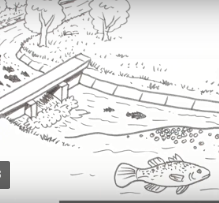
This engaging animation clearly explains the problems that irrigation channels can cause for native fish and how fish screens are proving to be an effective solution.
|
Gunbower Forest bird breeding event video
This short video shows how environmental watering programs can make a difference to the health and reproduction of water birds.
|
Barapa Wamba Water for Country River Tour 2019 video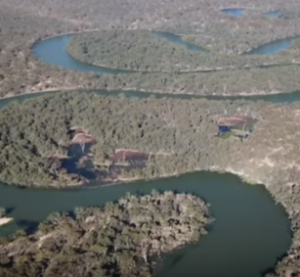
This video showcases an innovative NCCMA event for traditional owners to come together with land managers to spend time on country, learn from each other and allow time together on the river to strengthen relationships.
|
The Waterwatch Story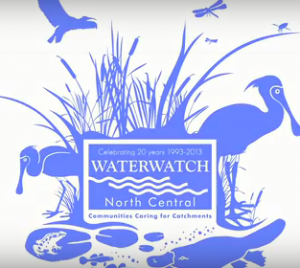
The North Central Waterwatch Program aims to increase the knowledge and skills of community, supporting them to become custodians of local waterways. River Detectives is the school/youth based component of the program. This video will help your students understand the community of passionate people that they belong to by being a River Detective.
|
Toxic Blackwater Explained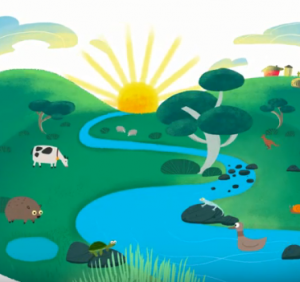
This video provides a simple explanation of the causes and effects of blackwater. And to learn how environmental water releases can help minimise the impacts of blackwater watch this video.
|
Water for the Environment; it’s all about timing
As well as the water in a river that naturally falls from rain, river and wetland flows are actively managed to maintain or improve their health and with the aim of achieving key ecological objectives such as:
This short video is an engaging animation that explains the issue simply.
|
Environmental Water and the Community video
The Loddon Murray Wetlands consist of one actively managed private wetland complex and 13 public-land wetlands located on the Murray and Loddon River floodplains. The wetlands are of international and/or regional significance and collectively cover an area of more than 2,800 hectares. This video highlights the importance of environmental watering to return natural watering cycles to waterways and wetlands in the north central region.
|
Lower Campaspe Flyover video
This 9 minute video shows edited footage of a drone journey along the Campaspe River from Axedale (just downstream of Lake Eppalock) to Echuca. Set to peaceful music it is a relaxing way to soar like an eagle over the waterway and start conversations about land practices along the way and strategies to balance river health with productive community life and agriculture.
|
Waterbug Face Facebook page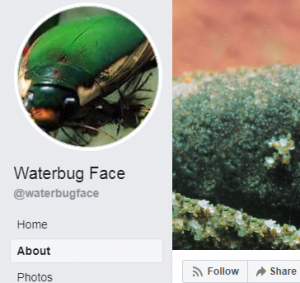
This page is run by freshwater ecologists dedicated to assisting with waterbug ID from photos. Send your image in for help with identification and check out posts for very cool photos and videos of waterbugs in action.
|
The Waterbug App
The Waterbug app helps you identify waterbugs from Australia. Work through the scientific key on your device to answer questions that help you identify your waterbug, or whizz through speedbug and see if you recognize it. A fantastic portable, paper-free resource for waterbug identification.
|
3 Rivers Flow Indigenous Hip Hop project video
Be inspired by this awesome video of Yorta Yorta children leading their mob in a song about their country defined by three rivers; the Campaspe, the Goulburn and the mighty Murray River. Maybe you could do a similar project with your students to tell (or sing) a story about your local waterway ?
|
Traditional Owner Campaspe River Tour video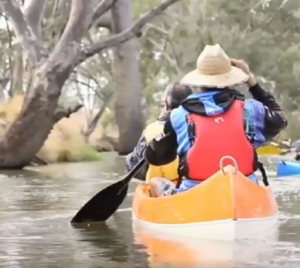
The NCCMA’s Caring for the Campaspe River project means more than just ensuring environmental values are protected and enhanced. The river has a rich cultural history and spending time there is a meaningful way for our Traditional Owners to connect with country and go on a journey of mutual learning with land managers.
|
In-Stream Habitat Poster
This poster is a fantastic resource to use during macroinvertebrate sampling sessions to demonstrate the five habitats that exist within a waterway; on the surface (surface zone), in open water (deep zone), amongst vegetation (reed zone), on rocks/logs/gravel (substrate zone) and amid the sediment (benthic zone). Use the links below to each quarter of the poster to print as A3, laminate and join for a class-size poster you can keep. Top left, top right, bottom left, bottom right Use the information on the reverse of the Waterbug Cards to have students place them in their correct habitat on the poster.
|
The Loddon River Seasonal Calendar
This beautiful poster can be used for inspiration to make a similar resource for a year in the life of your own waterway. Use words and pictures to document seasonal changes in weather, fauna, flora, water, land, agriculture and community life.
|
Murray Darling Basin video
This quirky 12 minute video provides an excellent explanation of how catchments work and the animals, plants, communities and livelihoods that depend on them being well managed. It highlights the importance of balancing the needs of the environment and humans. All waterways North Central, Wimmera and North East CMA regions are part of the southern most section of the Murray Darling Basin.
|
How Wolves Change Rivers video
When wolves were reintroduced to Yellowstone National Park in the United States after being absent nearly 70 years, the most remarkable changes occurred. Although this is an American example, this video is a powerful example of how everything in nature is inextricably linked and one change can cause a ripple effect, in this case called a ‘trophic cascade’.
|
Riparian Zone Poster
An excellent graphic to highlight the key features of a healthy riparian zone compared to a degraded riparian zone. Great for conversations about water quality, habitat health, land practices and shared community responsibility for the health of our waterways.
|
Water Quality Results Posters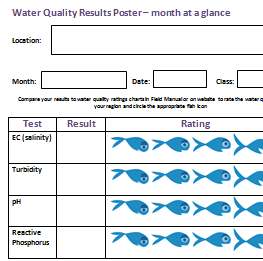
Use these posters to record and display your monthly or yearly results at a glance. Share them with others by printing in the school / community newsletter or displaying them in the classroom, school foyer or even a local shop or community meeting place.
|
pH Scale
This graphic is the perfect tool to introduce pH, explain acidity and alkalinity to students and compare your pH reading to everyday household items.
|
Salinity Scale
Use this resource to check the salinity tolerances of humans, crops, livestock, compare your EC results and understand how salinity can impact on all areas of life.
|
Traditional Owners Map
Victoria has a strong and proud Aboriginal history, and complex ownership and land stewardship systems stretching back many thousands of years. This map allows you to find out who the formally recognised Traditional Owners are for an area.
|
Waterbug ID chartUse this poster as a field guide to identify waterbugs in your sample, understand the in-stream habitats they prefer and use the sensitivity scores to rate the health of your waterway. It can be laminated (or similar) and used with white board markers for longevity.
|
Waterbug colouring sheetsUse Melbourne Water’s beautiful colouring images of waterbugs for education / relaxation. A mix of waterbugs Diving Beetle Dragonfly Larvae Sensitive waterbugs Freshwater Snail Mayfly life cycles Wetland waterbugs
|
Platypus colouring sheetUse Melbourne Water’s beautiful image of the platypus as a mindful colouring activity.
|
Carp Fact Sheet
Find out about this introduced fish species and how carp impact on our waterways
|
Who is your local Landcare group?
Landcare represents thousands of people across Victoria, working together to increase biodiversity and promote the sustainable management of land. Find out what your local group is doing and how your River Detectives program might be able to get involved. To find your local group visit the Landcare Gateway and search for the group nearest you by name, postcode or map location.
|
Barapa Barapa Field survey plant guide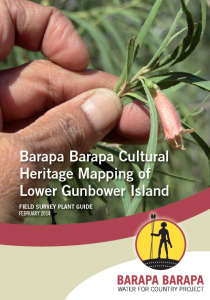
Find out more about plants in the Barapa Barapa region through pictures and descriptions of the plant, it’s habitat and it’s traditional uses.
|
Salinity in our waterways poster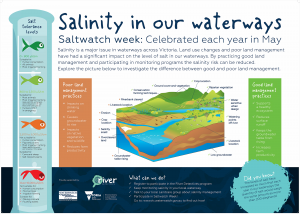
Use this poster to explore the issue of salinity and examine positive and negative land management practices that contribute to the issue.
|
Wimmera River Catchment map
This is a map depicting the catchment area of the Wimmera River. Part of the Wimmera Catchment Management Authority region, the area to the west of the Wimmera River, doesn’t actually flow into the Wimmera River. The West Wimmera area is instead a series of wetland chains.
|
Map your River
Follow the Teachers Guide to support students to draw a birds eye view of their water testing site with captions to highlight various features. The Riparian Zone Poster could be used as an example.
|
How to make a bug dial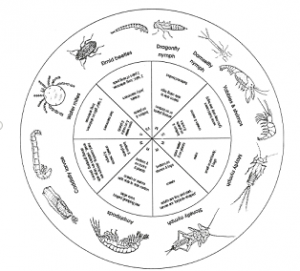
Make your own bug dial and learn more about the bugs you’ve identified. Find out about the way they move, their sensitivity to pollutants, where they live and special features.
|
Junior Landcare
Be inspired by activity ideas linked to the Australian curriculum in the Learning Centre, at Just For Kids with great activities for home and school and check out the 25 Junior Landcare Ideas encouraging Junior Landcarers to take action to protect the world around them. There are also fantastic grant opportunities for schools, youth groups, early learning centres and landcare groups.
|
Our platypus – information brochure (posters)
This brochure developed by Melbourne Water is useful for any region with great information presented in a very clear format that could be used as posters for the classroom.
|
Creating a frog friendly habitat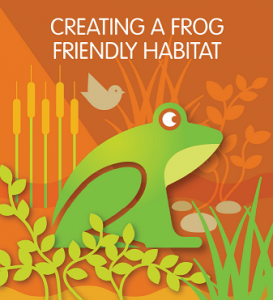
Find out all about how to create a frog friendly habitat
|
Waterbug Cards
Use these cards to;
|
Melbourne Water Catchments mapExplore the catchments of Melbourne!
|
Growling Grass Frog colouring sheet
Alternatively you could use Melbourne Water’s Growling Grass Frog activity sheet where the colouring is set amid some facts about the specie.
|
Frog Life Cycle colouring sheet
|
Frogs colouring sheet
|
Brain bending time fillers
Engaging activities to stimulate minds and consolidate learning in those idle moments in your classroom schedule
|
Corangamite CMA Catchment maps
The Corangamite CMA region is one of ten CMA regions of Victoria. This region has four catchments; Barwon River, Lake Corangamite, Moorabool River and Otway Coast. These can be broken down further into fifteen sub-catchments. Click the links below to find out which catchment/sub-catchment your town/waterway is in. See it from above and understand the way water flows in your area. Moorabool, Hovells, Leigh, Murdeduke, Mid Barwon, Upper Barwon, Bellarine, Woady Yaloak, Lismore, Stony Rises, Curdies, Gellibrand, Aire, Otway Coast, Thompsons.
|
North Central CMA Region 3D map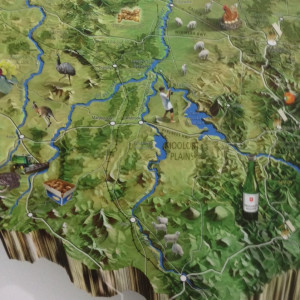
Enjoy a birds-eye view of the North Central region to understand our topography, catchments and land uses.
|
Turbidity Fact Sheet
|
pH Fact sheet
|
Exploring Estuaries GuideThis guide provides educators with a number of lesson plans linked to the Australian Curriculum. It supports estuary-related resources designed to enhance student understanding of this important water system..
|
Water Bug Flip Charts
An interactive resource about the most common macroinvertebrates. Set on a 5 cent piece, images help students understand the size and scale of waterbugs and when your mouse hovers on an image it flips to reveal a fact file of the bug’s name, size, physical features and interesting adaptions.
|
Nine days on Tang Tang Swamp
A beautiful and breathtaking secret insight into life on a drying waterhole at a public wetland located in north central Victoria
|
Fresh and Salty video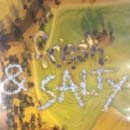
Fresh and Salty is a highly engaging short animated film produced by the Wimmera CMA. It is the perfect way to introduce the topic of salinity to your students
|

